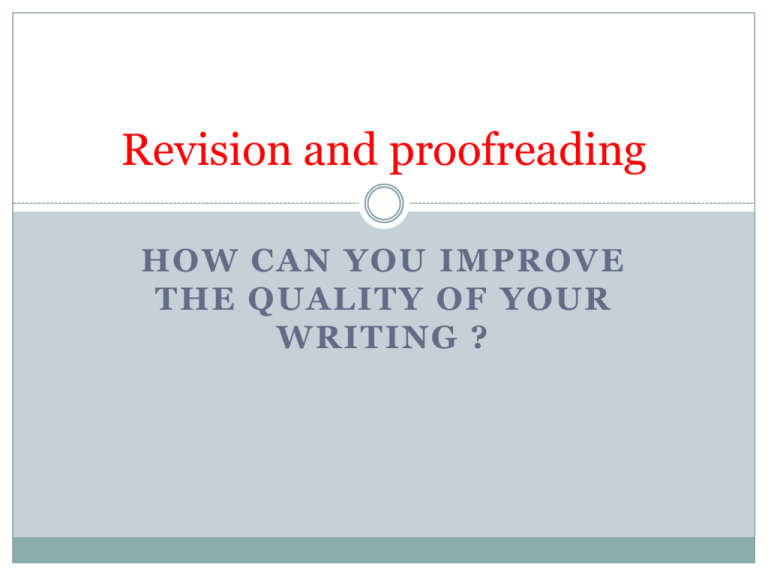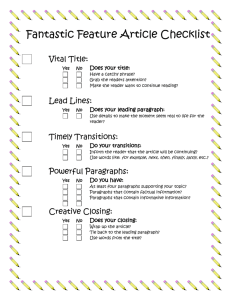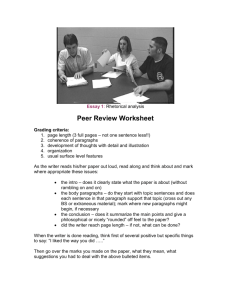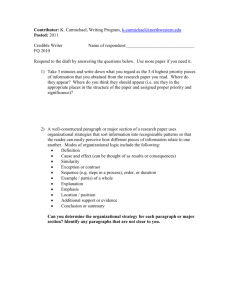Revision and proofreading - English 3 LIN-AZ
advertisement

Revision and proofreading HOW CAN YOU IMPROVE THE QUALITY OF YOUR WRITING ? Proofreading… After you finish revising so that your ideas are clear and well-organized, it’s time to proofread.. Go over your paper carefully with a pen in your hand Touch each word w/ the pen, and read it aloud, or in your head: this will help you to slow down and find errors and parts that don’t sound right You should discover words that are missing, or that the endings on words are not correct If you think a word may not be correctly spelled, top and check its spelling DRAFTING A first draft … should never be the final draft ! Is a chance to get your thoughts and impressions on paper May be disorganised and incomplete When you have a first draft, think about the changes you need to make. You may need to develop your ideas more, add details, or clarify confusing points. Preparatory reading… SKIMMING is often helpful to get a general idea of a piece of writing before you actually start reading it. Read the title and subtitles, if any Read the first sentence of all paragraphs Read the entire first and last paragraphs This will help you -to get the main idea and -to familiarize w/ the overall organization of the reading ANNOTATING is a way of reading with a pencil in hand. As you read, you mark up the text in any way that makes sense to you. Underline, circle highlight or (bracket) important or interesting words, phrases or sentences Draw ARROWS to connect related ideas Write comments and questions in the margins Not realistic ! Number points (1,2,3,4) Great idea ! Make any other markings that are meaningful to you ? !!! % @ £ =) =( ;-) Double entry response allows you to take notes on aspects of a reading that interest you, and your reaction to them Draw a line down the middle of a piece of paper. On the left-hand side, jot down interesting or important words, phrases, sentences, ideas, points, details and anything that ever catches your attention as you read the passage. You can write down the exact words (quote) or say some of the ideas in your own words (paraphrase) or re-tell some of the most important ideas or main events from the passage (summarize). Double-entry response… Then add your own comments on the right-hand side. You can: question the reading react to it relate it to other readings or your own experience, or express your thoughts and feelings about it Example of double-entry response: P. 27 “Inspired to Write” Writer’s tip: Be specific: it is much better to say “the geranium in the window” than “the flower in the window”. “Geranium” – that one word gives us a much more specific picture. It penetrates more deeply into the beingness of the flower. It immediately gives us the scene by the window – red petals, green circular leaves, all straining towards the sunlight” - Natalie Goldberg ‘No comprendo’ Finding the main idea in a reading is important… just as important as it is for the writer to have a main idea and to support it. The main idea is: The central idea or focus The main idea the writer wants to make The reader can usually find a sentence or two that best expresses it Sometimes it’s implied… you have to ‘read between the lines’ to find it Read the example from Inspired to Write, p. 34. No comprendo Can you find the main idea(s) ? The main idea Writers may start a piece of writing not knowing what the main idea is going to be… they may discover it only in the process of writing Once they do establish the main idea, the rest of the text will develop the idea by --giving examples and reasons --making comparisons and contrasts --providing information or data --referring to other texts or other support In the final piece of writing it should be easy to find the writer’s main idea and see that everyting in the text – the examples and the reasons– all relate to and support it. A descriptive outline can help you to see a piece of writing clearly. You can use it to help you understand something you read… or as a tool for revising your own writing. Include: The main idea in your own words In columns, one sentence summaries of what each paragraph “says” and “does” … the purpose or function of each paragraph (for ex., to introduce an idea, develop a reason, give examples, tell a story, describe something or someone, explain something, analyze a problem, summarize ideas, argue a point, provide a conclusion) example of descriptive outlining: After numbering the paragraphs… can you make a descriptive outline of ‘No comprendo’ ? Choosing examples…. S.T.A.R. Here are some criteria to help you choose and check your examples: SUFFICIENT: Do you have enough examples – or details or facts or evidence – to make your point strongly ? Is your support sufficient ? Of course, sometimes one strong detailed example is enough: “ People who get exercise tend to live longer than those who don’t. For example, my father walks 5 miles every day, and he is 90 years old.” S.T.A.R. TYPICAL: Is the example typical ? Does it represent the type of situation you want to make a point about ? Choose examples that are believable, that people would expect to see. Be careful though: if you choose an example that’s too common, it may seem stereotypical: “ Single parents can raise children just as well as two parents. A good example is a 7-year-old boy named Jimmy, whose parents both died, leaving him an orphan. His 20 year-old unmarried brother then raised him successfully. “ S.T.A.R. AUTHENTIC: Is the example true ? All your examples should sound true to the reader…. “ Television can influence children to do harmful or dangerous things. I once read about a young boy who watched a superhero show, then, with a cape tied around his neck, jumped off a roof in imitation.” S.T.A.R. RELEVANT: Is the example relevant to your point ? Will the reader see a logical connection ? “ One way to reduce the number of cars in cities might be to outlaw single passenger cars in the city center during peak hours. For example, some people in New York City propose that cars entering the center of the city in the morning hours be required to carry two or more passengers.” Writer’s tip: In the first draft you get your ideas and your theme clear…. But the next time through, when you revise your writing, it’s like cleaning house, getting rid of the junk, getting things in order, tightening things up. Revision is the process of making writing neat and orderly… like tidying up a room of your house. In an interview, Ernest Hemingway said: Hemingway: “I wrote the ending to A Farewll to Arms, the last page of it, 39 times before I was satisfied. Interviewer: “Was there some technical problem ? What was it that had you stumped ?” Hemingway: “ Getting the words right.” Getting the words right… Imagine you are the boss of a factory and the words you have written are your employees. If the workers are productive, they stay. If they are not doing there job well, or are not needed, they are fired or are let go. The ‘word boss’ must also recognize when to hire new workers, for ex. When there is a new job to be done and no one is doing it. Be a ‘word boss’ ! Go through your writing as a ‘word boss’. Look at each sentence carefully and ask yourself these questions: Is this word doing its job well ? Are there stronger, more specific, more explicit or more concrete words that could do the job better ? Do I need to hire any ‘new workers’ ? Could I add any words to make the meaning clearer ? Are there any unnecessary words in this sentence that need to be ‘fired’ ? Logical development To keep your reader engaged and enable him to follow your thinking, ask yourself the following questions to help ensure your writing flows from one idea to the next in a logical or coherent way: 1. 2. 3. 4. Does your essay fulfill the promise made in the first sentence / paragraph ? If not, what changes can you make, either in the beginning or in the rest of the essay ? Do the ideas in each sentence lead logically to the ideas in the next ? If not, what changes can you make to show a logical development ? Does one paragraph lead logically to the next ? If not, what changes can you make to show logical movement ? Does the entire piece hold the reader’s interest ? If not, what changes can you make to keep readers’ interest from section to section ? YOUR MISTAKES Remember to make a list of the most common mistakes YOU make…. And be ready to check your work for them….






